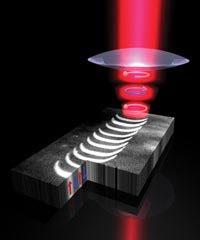
Magnetic Storage at Light Speed
Circularly polarized laser beams can increase the speed of switching bit states in magnetic media.
Hank Hogan
Researchers at Radboud University Nijmegen in the Netherlands and at Nihon University in Funabashi, Japan, have shown that the future of magnetic storage may involve light. The group demonstrated all-optical magnetic recording, switching the magnetization polarity without using a magnetic field. Instead, they employed a circularly polarized laser pulse, opening the way for faster recording speeds and speedier disk drives than otherwise would be possible.

Researchers have demonstrated all-optical recording of magnetic bits by scanning a circularly polarized laser beam across a sample. Local heating and the transfer of angular momentum from the photons change the magnetic polarity. Switching the direction of the polarized light reverses the magnetic polarity. Courtesy of Radboud University Nijmegen.
The technique works because of the nature of light, explained C. Daniel Stanciu, a graduate student at Radboud University Nijmegen. “The final magnetization direction — the bit of information — depends on the direction of the angular momentum of the photons, which is the origin of the magnetic nature of light pulses.”
He added that lasers already are being incorporated into disk drives in a technology known as heat-assisted magnetic recording. These lasers, however, are used only to selectively heat material, making it possible to impose a magnetic orientation. The technology offers bit densities potentially 100 times higher than is provided by current methods. It does require, however, both a laser and a magnetizing coil.
The group believed that, based on its previous research, a laser could do more than simply heat the material, and that all-optical switching via circularly polarized light was achievable, even though Stanciu noted that this was considered fundamentally impossible. Not only would an all-optical approach be simpler than one combining a coil and laser, but it also would be faster because switching the magnetization in a coil takes a relatively long time, whereas changing the polarization of light can be done quickly.
Under the direction of Theo H.M. Rasing, professor of physics at Radboud University Nijmegen, researchers demonstrated that light pulses alone could do the trick. They used a Ti:sapphire laser from Spectra-Physics of Mountain View, Calif., firing 800-nm pulses of 40-fs duration at a repetition rate of 1 kHz. They circularly polarized the pulses and sent them through optics, focusing them down to a 100-μm spot on a sample coated with a ferromagnetic alloy of gadolinium, iron and cobalt.
By recording magneto-optical images of the material through a lab-built microscope, they could see its magnetic domains and classify them as being magnetized either up or down. They then swept the laser across the domains, circularly polarizing it in one direction for one sweep and then in the other direction for the next sweep. For a control, they also linearly polarized the pulses in a third sweep.
Images after exposure to the beam showed that the linearly polarized light resulted in random magnetization, whereas the circularly polarized light forced the orientation of all domains either up or down. The effect was the result of a combination of local heating and the transfer of angular momentum from the photons to the material. Moreover, the process did not require much light. “For a certain laser fluence, we are able to control the direction of magnetization in the magnetic material by a single 40-fs laser pulse,” Stanciu said.
He added that a working device based on this principle might be constructed within the next five to 10 years. More research must be done before that happens, though, and the group now is working on optically switching domains as small as 100 nm or less.
In addition, a technological fix must be found before all-optical magnetic disk drives can be built. Inexpensive lasers with the right characteristics that can fire pulses of less than 100 fs must be fabricated in mass quantities, with potentially at least one in every disk drive shipped.
Physical Review Letters, Vol. 99, 047601, 2007.
Published: September 2007